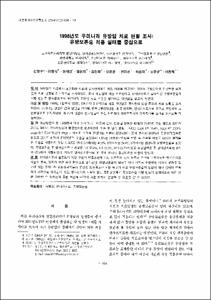KUMEL Repository
1. Journal Papers (연구논문)
1. School of Medicine (의과대학)
Dept. of Radiation Oncology (방사선종양학)
1998년도 우리나라 유방암 치료 현황 조사: 유방보존술 적용 실태를 중심으로
- Affiliated Author(s)
- 김진희
- Alternative Author(s)
- Kim, Jin Hee
- Journal Title
- Radiation Oncology Journal
- ISSN
- 2234-1900
- Issued Date
- 2004
- Abstract
- Purpose: In order to improve the proper 니se of radiotherapy and breast-conserving treatment (BCT) in the management of breast cancer, current stat니s of breast cancer treatment in Korea was surveyed nationwide and the use of BCT were evaluated.
Materials and Methods: Patients characteristics and treatment pattern of 1048 breast cancer patients from 27 institutions diagnosed between January, 1998 and June, 1998 were analyzed. The incidence of receiving BCT was analyzed according to the stage, age, geography, type of hospital, and the availability of radiotherapy facility.
Results: Radical mastectomy was performed in 64.8% of total patients and 26% of patients received breast- conserving surgery (BCS). The proportions of patients receiving BCT were 47.5% in stage 0, 54.4% in stage I, and 20.3% in stage II. Some of the patients (6.6% of stage I, 10.1% of stage II and 66.7% of stage IE!) not received radiotherapy after BCS. Only 45% of stage III patients received post-operative radiotherapy after radical mastectomy. The proportion of patients receiving BCT was different according to the geography and availability of radiotherapy facilities.
Conclusion: Radiotherapy was not fully used in the management of breast cancer, even in the patients received breast-conserving surgery. The proportion of the patients who received BCT was lower than the report of western countries. To improve the application of proper management of breast cancer, every efforts such as a training of physicians, public education, and improving accessibility of radiotherapy facilities should be done. The factors predicting receipt of BCT were accessibility of radiotherapy facility and geography. Also, periodic survey like current research is warranted.
Key Words: Breast Cancer, Radiotherapy, Breast-conserving treatment
목적: 유방암의 치료에서 표준화된 치료와 방사선치료의 적정 사용을 제고하기 위하여 유방암으로 진단받은 환자들의 치료 현황을 전국적으로 조사하였다. 특히 유방암의 최신 치료법이고 방사선치료가 필수적인 유방보존술의 시행 빈도를 분석함으로써 우리나라 유방암 치료 수준을 평가하고 개선점을 찾고자 하였다.
대상 및 방법: 1998년 1월부터 1998년 6월까지 유방암으로 최초 진단받은 환자들의 임상 특성과 치료 상황을 조사 하였다 조사대상 병원은 전국 병원을 지역별, 병원군별(3차병원 대 종합병원), 방사선치료시설 유무로 구별하여 표본병원으로 선정하였다. 총 27개 병원에 연구원들이 직접 방문하여 의무기록지와 암등록지를 토대로 조사표를 작성하였다.
결과: 유방암환자 총 1,048명에 대한 조사결과는 다음과 같다. 연령별 분포는 40대가 33.4%로 가장 많았고 50대가 28.5%, 30대가 22%이었으며 평균연령은 46.4세였다. 수술 후 병기 분포는 AJCC stage II가 58.4%, stage I이 23.5%, stage 0가 6%이었으며 stage II 이하로 조기에 진단되는 비율이 87.8%였다. 전체 환자의 64.8%가 전유방적출술을 받았고 26%의 환자가 유방보존적 수술을 받았으며 4.5%는 항암화학요법을 받은 후 수술을 하였고 4.6 의 환자들은 수술을 시행하지 않았다. AJCC 병기 0기에서는 47.5% I기에서는 54.4%, II기에서는 20.3%가 유방보존술을 받았다. 유방보존술 후 방사선치료 시행율은 I기 93.4%, II기 89.9%, III기 33.3%이었고 유방절제술 후 방사선치료는 III기의 45%에서 시행되었다. 지역과 방사선치료시설 유 무에 따라서 유방보존술 비율이 달랐다.
결론: 방사선치료의 활용도가 적정 수준에 미흡했는데 이는 의료진의 인식 부족과 주변에 활용가능한 방사선치료 시설의 부족, 경제적 여건 등이 원인으로 생각된다. 유방보존술의 활용도 역시 선진국 수준에는 미치지 못하고 있는데 이는 우리나라 유방암환자들이 유방을 보존하고자 하는 욕구가 적고 유방보존술의 장점에 대한 인식이 부족하기 때문으로 생각된다. 또한 방사선치료 시설이 없는 종합병원에서 유방보존술 시행 빈도가 상대적으로 적은 것을 관찰할 수 있었는데 주변 여건에 따라서 치료 방침이 결정될 수 있음을 알 수 있었다.
- Alternative Title
- The National Survey of Breast Cancer Treatment Pattern in Korea (1998): The Use of Breast-Conserving Treatment
- Department
- Dept. of Radiation Oncology (방사선종양학)
- Publisher
- School of Medicine
- Citation
- 신현수 et al. (2004). 1998년도 우리나라 유방암 치료 현황 조사: 유방보존술 적용 실태를 중심으로. Radiation Oncology Journal, 22(3), 184–191.
- Type
- Article
- ISSN
- 2234-1900
- Appears in Collections:
- 1. School of Medicine (의과대학) > Dept. of Radiation Oncology (방사선종양학)
- 파일 목록
-
-
Download
 oak-bbb-1042.pdf
기타 데이터 / 487.82 kB / Adobe PDF
oak-bbb-1042.pdf
기타 데이터 / 487.82 kB / Adobe PDF
-
Items in Repository are protected by copyright, with all rights reserved, unless otherwise indicated.